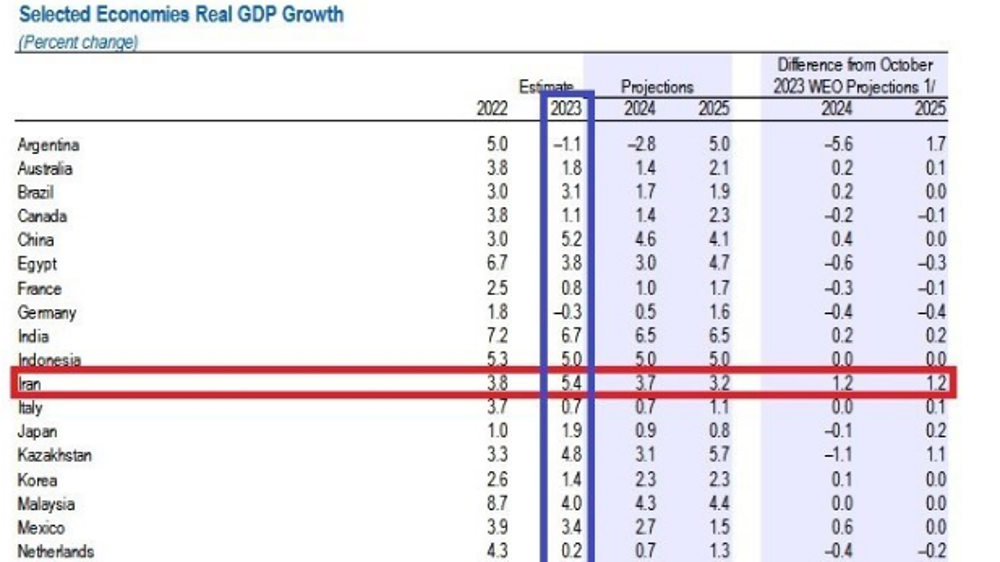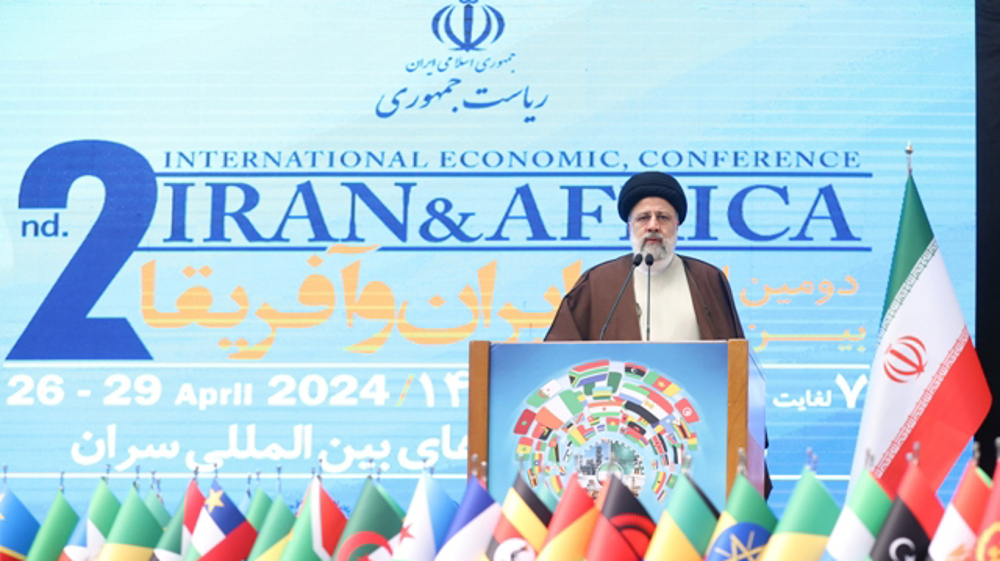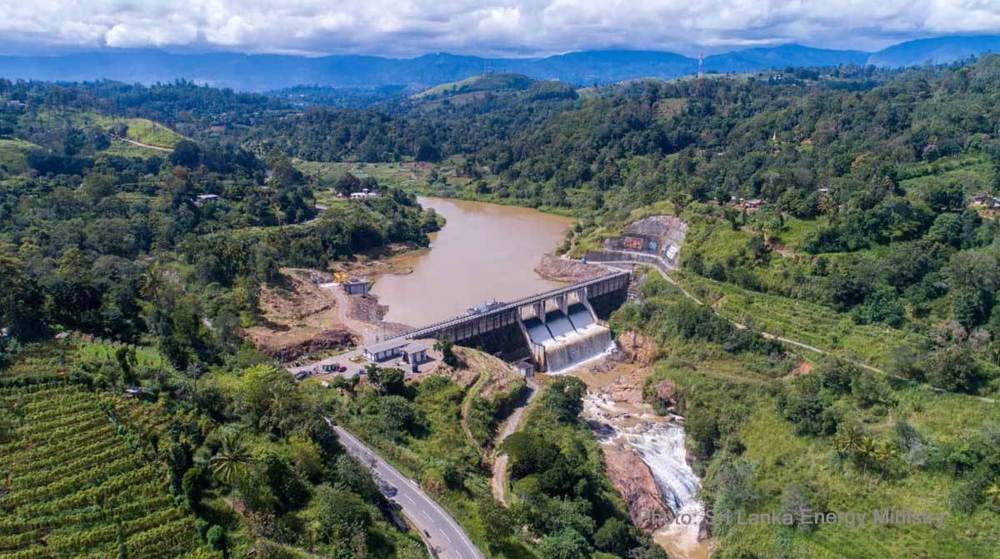The epic of Iran’s economic invincibility
Iran’s economy is likely to grow at 3.7% in the financial year of 2024 and at a similar pace (3.2%) the year after, the International Monetary Fund said in its World Economic Outlook in January.
The significant growth projection for Iran came as the report put the country among the top 30 economies in the world after India for the highest economic growth in 2023.
The 5.4 percent growth in 2023 has been unprecedented in recent years and the best performance of Iran's economy since the US withdrawal in 2018 from an international nuclear deal with Tehran and the implementation of a policy of maximum pressure on the country.
Iran’s better score among the 30 economies, which account for a total of 83% of the world's gross domestic product and include developed economies such as the US and Germany and developing countries such as Turkey, South Korea and China, is a major feat.
Countries such as Argentina, Saudi Arabia, Germany and Pakistan experienced economic stagnation and negative growth. Argentina and Saudi Arabia posted a negative growth of 1.1 percent while Germany’s economy shrank 0.3% and Pakistan’s contracted by 0.2%.
Last November, the Statistical Center of Iran reported a 7.1 percent increase in Iran’s gross domestic product (GDP) between June and August, almost half of which was due to energy sector growth.
The summer’s growth followed a similar 7.9 percent GDP increase in the previous quarter, also driven by the energy sector, with the service sector contributing as well.
The increase in the hydrocarbon sector, which grew 25 percent over the summer following nearly 20 percent growth in the spring, pushed the sector’s share of total GDP to over 15 percent, up from 13 percent over the same period in 2022.
The service sector remains Iran’s largest, with financial intermediaries driving its gains. By contrast, manufacturing and real estate showed modest gains over the summer and decreased as a share of GDP compared to the same period last year.
As the Iranian economy grew, unemployment dropped to an official 7.9 percent, while the labor force participation rate increased.
Ordinary Iranians may not see much benefit from such positive indicators in their daily life. Inflation hovered just short of 45 percent in November, a slight decrease from 49 percent in May but still higher than a year ago.
Nevertheless, figures show Iran’s economy continues to function and produce goods and services which are essential to satisfy the needs of the country after six years of US “maximum pressure”.
In fact, the Biden administration has continued of the same policy initiated by its predecessor in 2018, based on the logic that the weaker Iran’s economy is, the more likely Tehran will bend to Washington’s will.
The economy’s resilience is further evidenced by the fact that in the first nine months of the Iranian fiscal year starting in March 2023, GDP grew by a 6.7% annual rate, and finished the year with a growth rate exceeding the World Bank and IMF forecasts of about 4%.
Since 2020, the economy has grown steadily, if slowly, by about 4% per year.
On the diplomatic front, Iran’s success to repair relations with its Persian Gulf neighbors, enter the BRICS group of rising non-aligned global players and join the Shanghai Cooperation Organization has boosted its ability to resist US sanctions in the long run.
While these successes have yet to translate into more investment and economic growth, the Islamic Republic’s strategy of resistance to US pressure has raised its global stature and taken the sting out of unilateral sanctions, paving the way for Iran to turn its newfound geopolitical capital into economic growth.
Nevertheless, the country is under pressure for short-term dividends of the newfound capital as ordinary Iranians are overstrained after more than a decade of decline in their living standards and their resilience in the face of sanctions. Inflation remains high and household expenditures are under pressure.
The weak link in changing the situation for better is the management of the economy which has been tainted by years of misconceptions.
Unlike many oil exporting states, Iran has a highly diverse economy - marked by the availability of a unique resource base, both natural and human, and its promising geo-strategic position - which has demonstrated an ability to adapt to new realities fast.
With more than half of GDP being services-based, the economy is inherently resilient to occasional fluctuations in other sectors, such as petroleum, industry and mining, agriculture and construction.
This massive potential has been undermined by external sanctions as well as internal shortcomings linked to incompetence, corruption and mismanagement where short-termism caused by political, legal and operational uncertainties continues to impede the realization of the country’s economic potential.
While Iran’s officials describe the current situation as an “economic war”, appropriate policies are needed to fight it off since the Iranian economy has the potential to regain a new balance and to start growing again.
Navy escorts Iranian ships in Gulf of Aden, Atlantic Ocean to ensure safety: Cmdr.
Israeli minister urges killing instead of kidnapping Palestinians in Gaza
VIDEO | In Kashmir, India’s general elections inspire hope
KFC shutters 100 restaurants in Malaysia over pro-Palestine boycott
VIDEO | French police crack down on anti-Israel protests at Sorbonne
Iran says IsDB approved its proposal for preferential financing
Persian Gulf security to be ensured with participation of littoral states only: Iran
VIDEO | Press TV's news headlines











 This makes it easy to access the Press TV website
This makes it easy to access the Press TV website